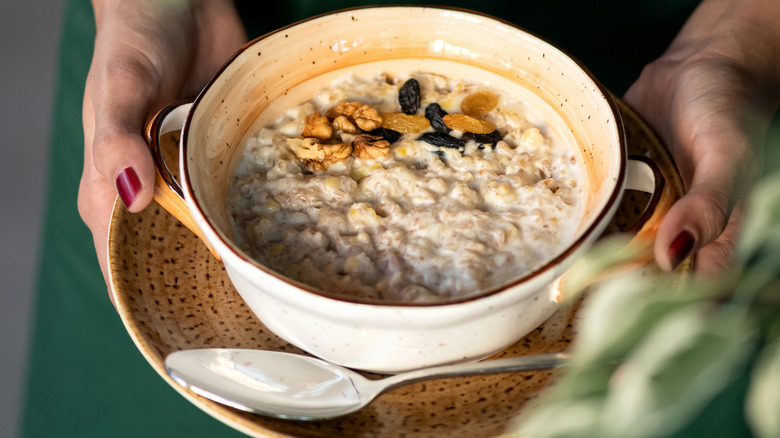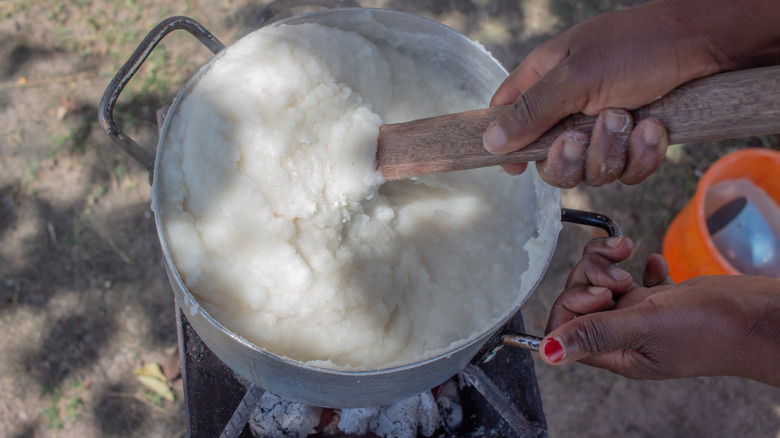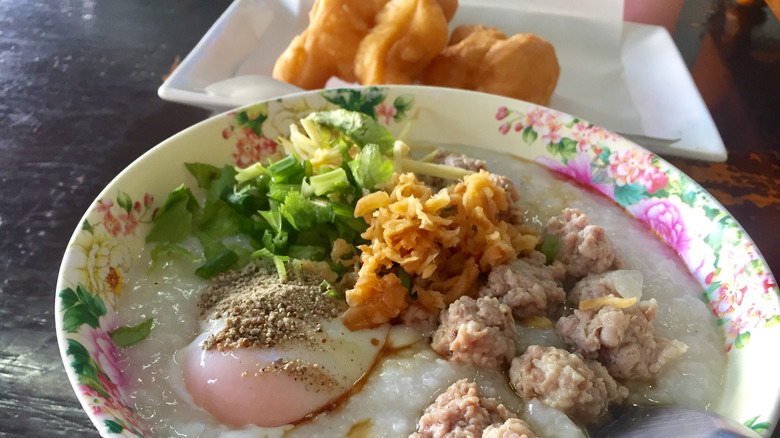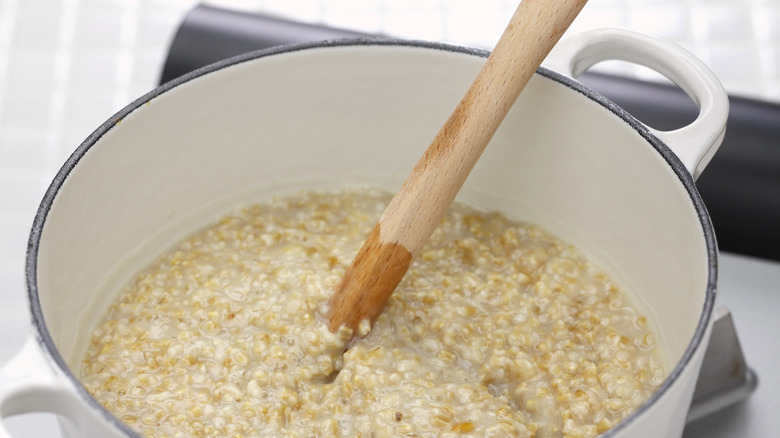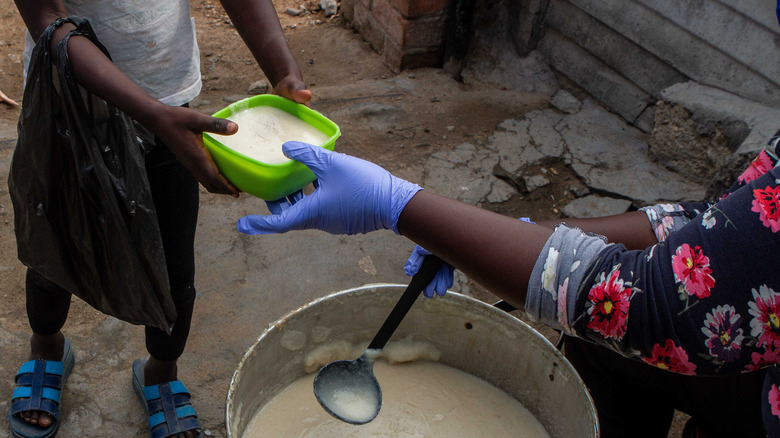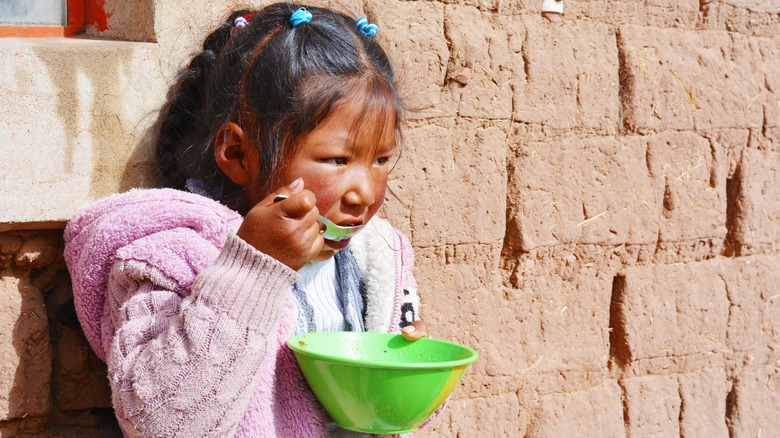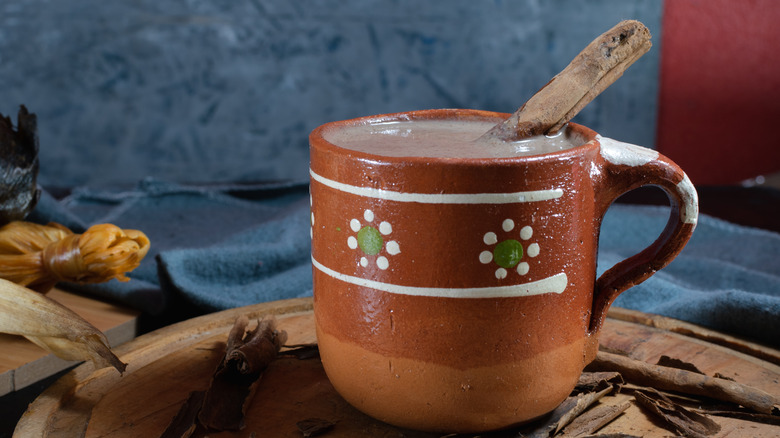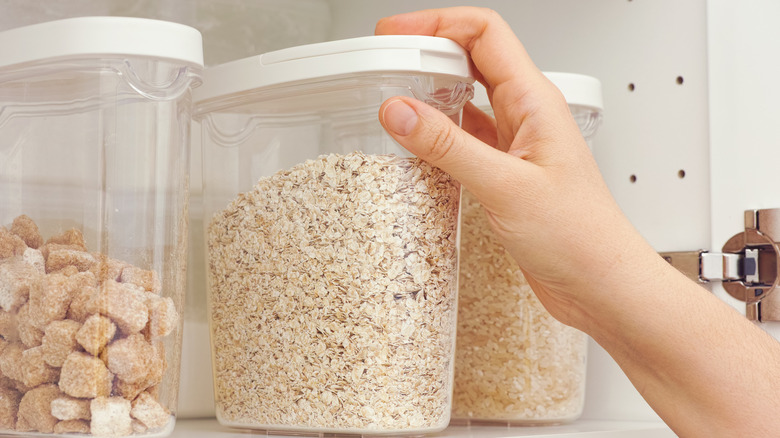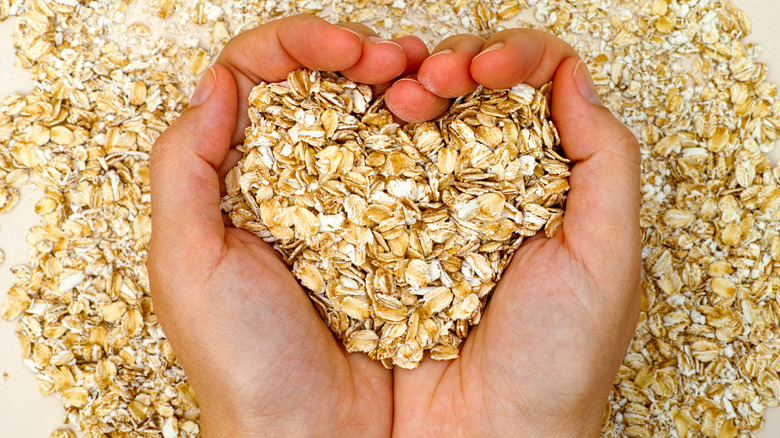The Untold Truth Of Porridge
A hot-cereal breakfast, porridge is a traditional staple that is not only delicious, but also nutritious. The little orphan boy, Oliver Twist hadn't had enough gruel when he said, "Please sir, I want some more," in the eponymous Charles Dickens novel and its depiction of Victorian deprivation. However, this idea of porridge being a dish of last resort is outdated and today porridge is a hearty, nourishing dish served up across the globe with some interesting grains of history mixed in.
Porridge ranges from a thin, watery broth-like consistency to really thick pastes you can stand your spoon up in. Often made with either milk or water, and salt, while some people swear that they hate porridge there is an argument that this is only because they're making it all wrong (via Medium). As with many simple recipes, it's so easy to mess up porridge so that it is too gruel-like or has the consistency of wallpaper paste. Made using simple ingredients, perhaps the most important of all is to make porridge from the heart, just the way you like it. With so many varieties and variations, the untold truth of porridge is that it is far more exciting breakfast fare than it may at first appear. In fact, it is a versatile dish to wake up to, and a healthy one as well.
Porridge has been around for thousands of years
The Mayo Clinic explains that the Paleo diet is often referred to as the Stone Age diet and this generally includes meats and vegetables, along with fish, nuts, and seeds. It excludes certain foods, however, such as grains and dairy, meaning that porridge made from oats is definitely off the list. Reports suggest this restricted meal plan is sometimes used to aid weight loss, with plenty of paleo-loving celebrities apparently trying to shed the pounds this way (via Everyday Health). Advocates believe that this way of eating responds in the best way to our human genetic makeup. However, there's no denying that as far as breakfast cereals are concerned, porridge has stood the test of time.
A New Scientist article suggests that folks way back some 32,000 years ago may have been making their own version of porridge. A grinding stone was found in Italy dating back to these times and there is scientific evidence that grains, including oats, were ground up using this tool. It's often believed that grains only became popular later than this period, with the advent of more modern farming methods. this is not the case. Oats were grown much earlier, around 7000 BC, while the Ancient Greeks were also porridge lovers (via Short Notes of History). Oats and similar crops came to Europe via the Romans, with the word cereal being named after Ceres, the Goddess of Agriculture. Meanwhile, oats were grown in the U.S. in the 17th century.
Oatmeal is porridge, but porridge is not just oatmeal
The words oatmeal and porridge are often used interchangeably in common parlance, but they are not actually the same. Oatmeal is a porridge made using oats, not surprisingly, but porridge includes a far wider definition and can be made using corn, barley, or rice. There are lots of ways to prepare these hot cereals too and it really comes down to a matter of taste. A simple porridge recipe can be useful as a starting point and once the desired taste and consistency is achieved, toppings can be added which range from brown sugar to honey, a splash of cold milk, or even some berries, while slices of banana are great or even some butter, A great way to eat these wholesome grains is to follow a simple overnight oaks recipe and enjoy a crunchy yet soft and cold breakfast cereal treat.
Oats come in many different forms (via Happy Herbivore), however, porridges that require some cooking are made from rolled oats which have been steamed or steel-cut ones which take longer to cook. Oats that have been steamed and cut are used in quick porridge recipes, while instant oatmeal is made from oats that have already been cooked. Even with oatmeal, there is so much choice, while healthy eaters should look out for sugar that is sometimes added to instant oat brands.
Asian countries have their own style of porridge
In Asia, porridge made from rice instead of oats is super popular as a breakfast food, and sometimes eaten later in the day as a comfort food too. The name for this type of porridge is congee, and while it may be eaten first thing in the morning it is most definitely a savory dish and not sweetened up as it is in the U.S. and many other parts of the world.
In Thailand, congee is also known as jok, but for many finding their favorite jok shop or ingredients to cook at home is no joke. Such is the Thai's love of this morning bowl of soft, soupy grains that restaurants just serving it are often open at first light, running out before the day has really started. In this part of the world, chili flakes, and fish sauce or soy sauce are added to suit personal tastes at the table, with glass jars or condiments to personalize the porridge. Thin strips of ginger and green onion are sprinkled on top too, while ground pork is cooked in the porridge, and a soft half-boiled egg is scooped out of its shell into the broth, cooking as it is eaten, with the golden yolk breaking to add richness to the grains. Crispy, deep-fried Thai-Chinese style doughnuts are served on the side and are often dipped into the porridge to add some crunch.
The Scottish spurtle and porridge drawer
One country where porridge is a rich part of the heritage has to be Scotland, and oats help to start what is often a cold day, finding a place in the traditional Scottish breakfast, along with oatcakes and haggis (via Scottish Scran). Such is the cultural importance of eating porridge in this part of the world, that there are plenty of interesting customs surrounding it. For example, Porridge Lady explains that the mixture is stirred with a special wooden stick called a spurtle. Its rounded shape, including a curved end is designed so that the porridge is cooked without becoming lumpy or without the oats being dragged along with a spoon with a flatter edge. Superstition suggests that porridge should only be stirred clockwise and be eaten in a wooden bowl.
Thinking of the gloopy consistency of this dish, it's difficult to imagine that in Scotland it was, once-upon-a-time, kept in a specially made drawer. However, The Press and Journal confirms that porridge drawers did exist, albeit that the mixture going into them was thicker and kept in such a wooden drawer so that the leftovers could cool and stay fresh. According to an article on foodie and recipe website The Spruce Eats, porridge at this point in time was so dense that it was actually eaten in slices and served cold for lunch, as well as being fried in the morning.
World Porridge Day and Mary's Meals
Did you know that there is a World Porridge Day? Well, there is, and according to hunger-fighting charity Mary's Meals, it falls on October 10 each year. In fact, there is also a National Porridge Day on June 23 in the United States, too. While many days denoted to celebrate a particular food are often aimed at highlighting its nutritional value, the extra worth with World Porridge Day is that its purpose is to help children who are in need in countries that are developing.
Mary's Meals organizes this day, raising funds to help youngsters who don't have enough food in countries such as Malawi, feeding them porridge to help their development. The organization focuses on food and education, helping more than 2 million kids in 19 countries. It's a lovely thought that a simple dish, with so much history, and with local roots in Scotland could end up being part of a legacy that reaches out to feed so many of those without. Food is about sustenance, sharing, and love, and a big pot of porridge can be food for thought to inspire charitable acts for those who have less and suffer from poverty and hunger.
Grits originated as a Native American corn dish
In the U.S., and particularly in the Southern states, grits is a much-loved breakfast food. The origins of this corn-based porridge can be traced back to a Native American dish called grist (via Edible Northeast Florda). Taste Atlas describes how corn grains are boiled and served as a side at breakfast. Grits are not a sweet dish, and this porridge is served up in a classic Southern recipe of shrimp and grits. It was the Muscogee (Creek) tribe from Alabama who shared their hominy recipes, while other tribes were creating their own versions. It's part of its charm that grits has such an interesting history and how it is still so popular today.
An expert on grits perhaps is writer Erin Byers Murray who wrote "Grits: A cultural and Culinary Journey Through the South." She traces this dish, which was once primarily for the poor, to the kitchens of African Americans in the southern part of the U.S., while also suggesting that cooks in Central America as far back as 8700 BC made some type of corn and water dish. The history of grits, and porridge in general touches on histories about class, race, and culture, as well as traditions and legacies, passed down through generations. As NPR points out, lowly grits and Southern food are now found on high-end menus and grits is definitely a favorite for diners everywhere.
Porridge has global appeal
Porridge is not just limited to the U.S. and Scotland — it's a staple across the globe, with some pretty interesting variations along the way. These are highlighted in an article in Paste magazine, "11 Comforting Porridges from Around the World." As well as congee in China and other parts of Asia and grits in the U.S., as mentioned earlier, it seems plenty of other countries have their own unique hot cereal dish in one form or another.
For example, in Italy polenta is used instead of oats, while in India porridge is made using semolina. Meanwhile, in Mexico champurrado is a thick corn-inspired drink that is sometimes spiced and more often than not sweetened. The brew was created by the Aztecs, with another key ingredient being cacao beans. In the Philippines, a similar dish to congee is served with garlic, green onions, and lime juice. What porridge is to different countries, cultures, and people may be different, but what is clear is that the love of warm, comforting food crosses all boundaries and brings everyone together in some way.
Oatmeal is found in 80% of US household cupboards
According to a Quaker's fact file, there are some pretty interesting nuggets of information about oatmeal, such as that four out of five households in the United States have oatmeal stored in their cupboards. There is no doubt that oatmeal has always been a must-have basic for the pantry. As well as being used to create porridge, oatmeal is versatile and can be used in other recipes too. Oatmeal cookies are top of the list and meatloaf is second, proving there is more to this grain than being a cereal ingredient.
The focus may be on food today, but oats have also long been used for their medicinal properties as well. They are important in Traditional Chinese Medicine or TCM (via Chinese Nutrition.org) in which they are renowned for their restorative powers and as a tonic for the blood and qi which is a vital life force. TCM utilizes oats to tackle many different ailments from inflammation to anxiety, as well as calming the skin.
Gluten-free grains of goodness
While some porridges may seem stodgy or even sticky, oatmeal is something of a superfood and is packed full of nutrients. A look at the healthy benefits of oats and this gluten-free food is what attracts so many health-conscious people to add porridge to their meal plan. Not only do oats offer the goodness of a wholegrain, but they are a rich antioxidant which is necessary for the body to protect against free radicals caused by pollution and lifestyle factors. With heart disease being a huge killer globally, a fiber-rich source of beta-glucan can, according to studies, reduce cholesterol significantly (via Healthline).
You don't need to be a scientist to know that porridge fills you up and is a great way to start the day with plenty of good-quality fuel to power you through until lunch at least. As food choices grow and trends take over, there's a lot to be said for taking breakfast back to a time when life seemed less complicated, when all you really needed was some oats and a long wooden spoon. Porridge is about getting back to basics, stripping away modern additives, and enjoying the good taste of Mother Nature.
